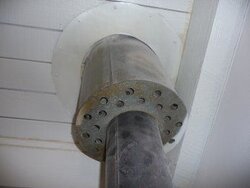I am replacing my existing pellet stove.
I need advice and help with understanding what to replace/buy/fix/repair with the existing single-wall 6" stove pipe.
I bought a 15 year old Lopi Answer wood burning stove in fabulous condition.
Please see attached photos showing my existing pellet stove (will be removed and replaced with the Lopi wood burning stove). The existing pipe inside the home is 6" single wall, feeding into a thimble. The ceiling thimble uses 8" pipe, and the 6" pipe is simply pushed a few inches up into the 8" pipe with an air gap between the 6" and 8" and another air gap between the 8" pipe and the thimble (more than 12" diameter). The whole contraption leaks air like having a window open ... but my carbon monoxide detector is quiet, so I guess the fumes are exiting the home. I will be burning mostly pine, and a little oak because that is what I have.
I'm also searching for a used Lopi Declaration Plus wood fireplace insert, and I will need a standard 6" chimney pipe for it. My chimney is in good condition, but about 40 years old, cleaned recently.
I need advice and help with understanding what to replace/buy/fix/repair with the existing single-wall 6" stove pipe.
I bought a 15 year old Lopi Answer wood burning stove in fabulous condition.
Please see attached photos showing my existing pellet stove (will be removed and replaced with the Lopi wood burning stove). The existing pipe inside the home is 6" single wall, feeding into a thimble. The ceiling thimble uses 8" pipe, and the 6" pipe is simply pushed a few inches up into the 8" pipe with an air gap between the 6" and 8" and another air gap between the 8" pipe and the thimble (more than 12" diameter). The whole contraption leaks air like having a window open ... but my carbon monoxide detector is quiet, so I guess the fumes are exiting the home. I will be burning mostly pine, and a little oak because that is what I have.
I'm also searching for a used Lopi Declaration Plus wood fireplace insert, and I will need a standard 6" chimney pipe for it. My chimney is in good condition, but about 40 years old, cleaned recently.





